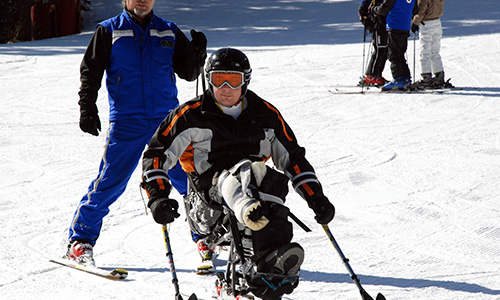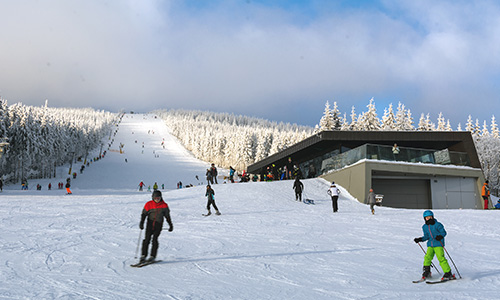Skiing for the First Time?
Author

Chris shares his passion for cycling, hiking, skiing, and climbing from Buxton, in the Peak District. As a blogger for Outdoor Look, Chris shares outdoor tips and indoor tricks to help you get the most out of your time spent outside. When he's not out adventuring he's making videos or trying to keep up with his 4-year-old son.
 Whether you are an expert or a beginner in skiing, staying fit is of upmost importance. You can enjoy skiing to the fullest only if you can tackle the challenges that you face on the slopes. And for this, you should be both physically and mentally ready. This post lets you know about the factors on which skiing depends and how you can train yourself for them.
Whether you are an expert or a beginner in skiing, staying fit is of upmost importance. You can enjoy skiing to the fullest only if you can tackle the challenges that you face on the slopes. And for this, you should be both physically and mentally ready. This post lets you know about the factors on which skiing depends and how you can train yourself for them.
Crucial Factors of Skiing
Skiing is a whole-body workout which requires a basic level of cardio training. In order to enhance your strength for skiing, you should work on various fitness training rather than just focusing on one cardio workout.
Fitness trainers are of opinion that flexibility, endurance, stability, and balance are the vital factors to ski safely on the slopes. An individual should follow a fitness program which focuses on each of these factors.
- Make your body Flexible
You should improve the flexibility of your body, especially your hips and knees, so that they can effectively respond to the unforeseen situations on the slopes. You must practice the five yoga poses featured by ESPN. The chair pose will help strengthen your legs for the toughest run. The bow pose is really helpful to open hip flexors and relax the whole body. These poses will make your body more flexible to avoid injuries.
- Are you Able to Maintain Balance?
For a beginner it’s really important to gain balance. If you’re able to balance yourself on a particular surface, then you would be able to stay stable and improve your skiing performance. Leg strength is required most for the balance and it should be improved for the protection of the knees.
Initially a novice skier should focus on standing on your skis in an upright position.
- Upgrade your Strength and Stability
The varied surfaces on the slopes are one of the biggest challenges while skiing. Core strengthening is the key! There will be a great improvement in your performance if you’ve a strong core. One of the simplest ways to upscale your strength and stability is running on diverse terrains. Choose a rough trail or muddy surface for running. This way your legs and ankles would become familiar to different surfaces and ensure your stability that would eventually prevent injuries.
- Endurance Matters
 Whatever plan you choose to go downhill or stop for a rest break or to click pictures, an interval is necessary. Why? Well, endurance is must. Interval training is a combination of high to low intensity cardio intervals which help you build endurance to resume skiing with a greater strength. You can concentrate on 5-10 intervals each of 30-60 or 60-120 seconds. Give yourself recovery time of about a minute. If you want to analyse which muscles work the most while skiing, join swimming sessions. Once, you know the most used muscles, start your training accordingly.
Whatever plan you choose to go downhill or stop for a rest break or to click pictures, an interval is necessary. Why? Well, endurance is must. Interval training is a combination of high to low intensity cardio intervals which help you build endurance to resume skiing with a greater strength. You can concentrate on 5-10 intervals each of 30-60 or 60-120 seconds. Give yourself recovery time of about a minute. If you want to analyse which muscles work the most while skiing, join swimming sessions. Once, you know the most used muscles, start your training accordingly.
- Do not Miss Cross-training
Make sure you are cross-training. It is a combination of workouts which will help provide your body with flexibility, strength, stability, and endurance. The yoga poses will work to improve your strength, flexibility and balance while strength training will enhance your stability and endurance.
Skiing is a combination of balance, cardio, and strength training which not only avoids injuries but also boosts your performance. If you are planning for a ski holiday, follow the above tips to train yourself in advance for an amazing ski experience.
Author

Chris shares his passion for cycling, hiking, skiing, and climbing from Buxton, in the Peak District. As a blogger for Outdoor Look, Chris shares outdoor tips and indoor tricks to help you get the most out of your time spent outside. When he's not out adventuring he's making videos or trying to keep up with his 4-year-old son.
- Speed Up Your Post-Hike Recovery with These 6 Essential Tips
- Cycling through Tranquil Roads and Coastal Views on the Isle of Wight
- The Essential Guide to Hiking Safety: 5 Tips Every Hiker Should Know
- Run Smart, Run Strong: Your Guide to Injury-Free Running
- Embrace Biking: Essential Tips for Beginners
Categories
- Sport (28)
- Product Reviews (3)
- Team Outdoor Look (7)
- Mike Wild (2)
- Mike Payton (2)
- Suse Hammond-Pears (3)
- Snowboarding (12)
- Latest Offers (105)
- Shop Talk (1)
- Competitions (7)
- Walking (413)
- Lifestyle Fashion (8)
- Travel (86)
- Kit Guides (176)
- Workwear Clothing (6)
- Safety Workwear (4)
- Health/Fitness (289)
- Skiing (91)
- Great Outdoors (1316)
- Cycling (92)
- January 2025
- December 2024
- November 2024
- October 2024
- September 2024
- August 2024
- July 2024
- June 2024
- May 2024
- April 2024
- March 2024
- February 2024
- January 2024
- December 2023
- November 2023
- October 2023
- September 2023
- August 2023
- July 2023
- June 2023
- May 2023
- April 2023
- March 2023
- February 2023
- January 2023
- December 2022
- November 2022
- October 2022
- September 2022
- August 2022
- July 2022
- June 2022
- May 2022
- April 2022
- March 2022
- February 2022
- January 2022
- December 2021
- November 2021
- October 2021
- September 2021
- August 2021
- July 2021
- June 2021
- May 2021
- April 2021
- March 2021
- February 2021
- January 2021
- December 2020
- November 2020
- October 2020
- September 2020
- August 2020
- July 2020
- June 2020
- May 2020
- April 2020
- March 2020
- February 2020
- January 2020
- December 2019
- November 2019
- October 2019
- September 2019
- August 2019
- July 2019
- June 2019
- May 2019
- April 2019
- March 2019
- February 2019
- January 2019
- December 2018
- November 2018
- October 2018
- September 2018
- August 2018
- July 2018
- June 2018
- May 2018
- April 2018
- March 2018
- February 2018
- January 2018
- December 2017
- November 2017
- October 2017
- September 2017
- August 2017
- July 2017
- June 2017
- May 2017
- April 2017
- March 2017
- February 2017
- January 2017
- December 2016
- November 2016
- October 2016
- September 2016
- August 2016
- July 2016
- June 2016
- May 2016
- April 2016
- March 2016
- February 2016
- January 2016
- December 2015
- November 2015
- October 2015
- September 2015
- August 2015
- July 2015
- June 2015
- May 2015
- April 2015
- March 2015
- February 2015
- January 2015
- December 2014
- November 2014
- October 2014
- September 2014
- August 2014
- July 2014
- June 2014
- May 2014
- April 2014
- March 2014
- February 2014
- January 2014
- December 2013
- November 2013
- October 2013
- September 2013
- August 2013
- July 2013
- June 2013
- May 2013
- April 2013
- March 2013
- February 2013
- January 2013
- December 2012
- November 2012
- October 2012
- September 2012
- August 2012
- July 2012
- June 2012
- May 2012
- April 2012
- March 2012
- February 2012
- January 2012
- December 2011
- November 2011
- October 2011
- September 2011
- August 2011
- May 2010
- April 2010
- March 2010
- February 2010
- January 2010
- November 2009
- October 2009
- September 2009
Submit a Comment